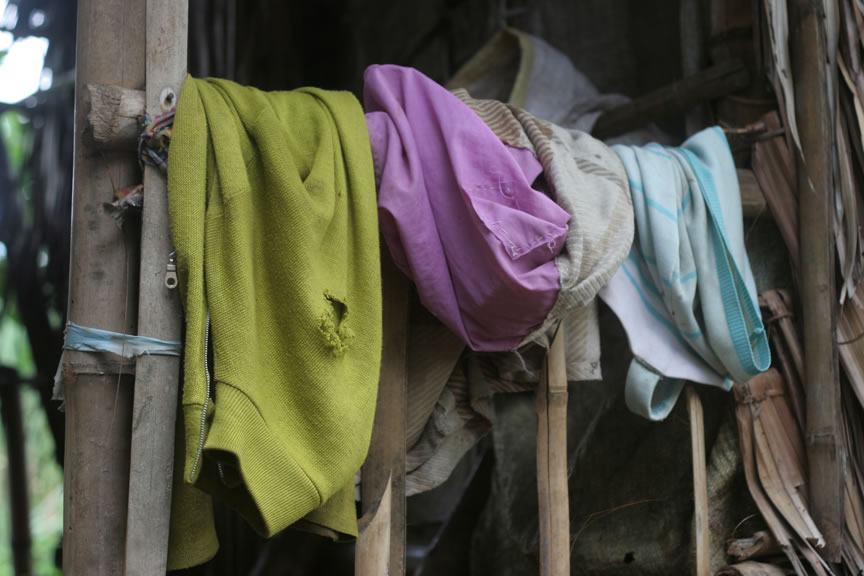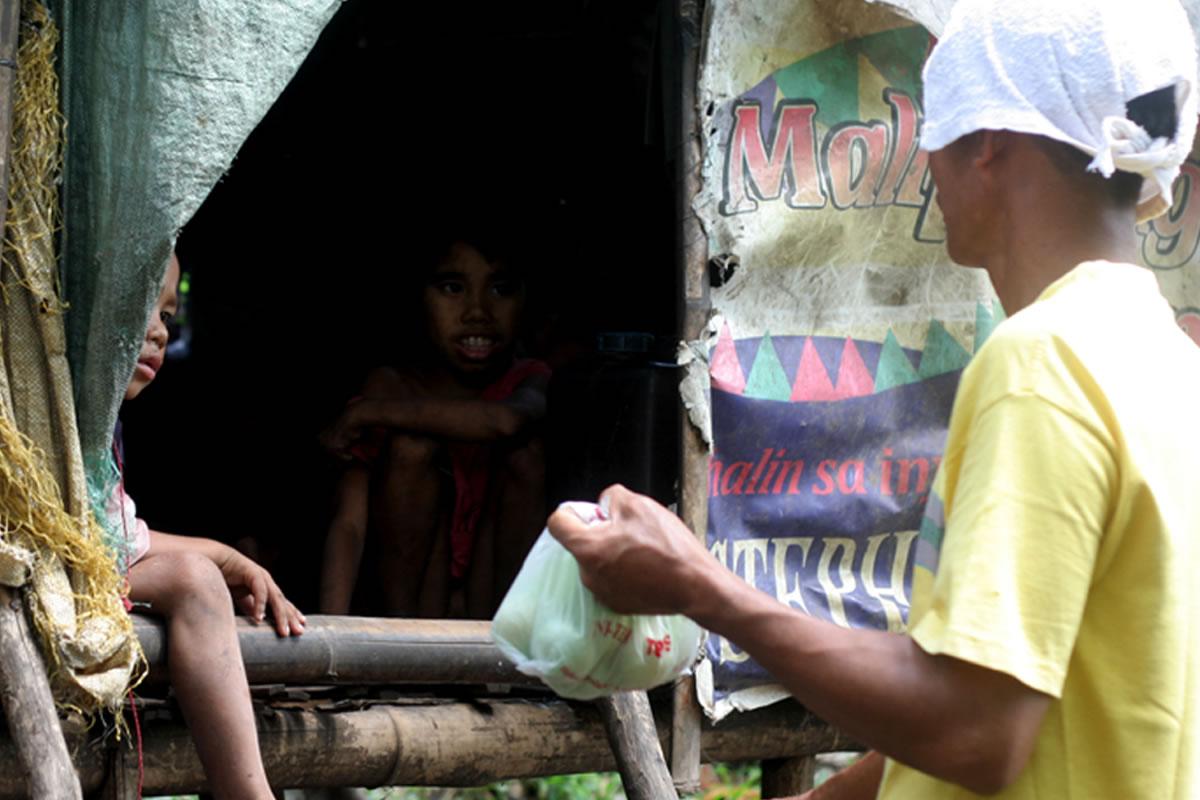
PAGLANSANG KAY HESUS
The nailing of Christ to the cross is re-enacted during the Kalbaryo or the Calvary of Christ in the central Negros city of La Carlota. The start of the Holy Week also signals the start of the tiempo muerto, the dead season also called the off-milling season that lasts for up to six months.
Photo by Julius D. Mariveles
CUARESMA or Holy Week is the time when Filipinos reflect on the agony of Jesus Christ. It is also the time when the mamumugon — the workers in the vast haciendas or plantations of Negros Occidental — slip into a suspended state between life and death, a seeming purgatory on earth.
This is Tiempo Muerto, the dead season in the Philippines’ sugar bowl, a period between the planting and harvesting of sugarcane. It lasts from April until August, and is a season that the sugar plantation workers dread more than the typhoons that enter the country also around this period.
To both the dumaan or the regular farmhands and the sacada, the seasonal ones, Tiempo Muerto is the tigkiriwi, which literally translates to the pained expression on their faces, as work either slows down or stops in the fields. Wages then plummet to less than one U.S. dollar a day, not even enough to buy a kilo of well-milled rice.
“Mangita gid ko trabaho sa iban nga kampo (I have to look for jobs in other canefields),” says third-generation sugarworker Renato Britanico when asked what he does during tigkiriwi. At best, he may earn P130 a week for weeding the canefield or doing other minor jobs.

LESS THAN A DOLLAR
A shopping list for the day amounts to only P32 or less than one US dollar.
Photo by Julius D. Mariveles
Britanico and the rest of the more than 300,000 workers in Negros’s sugar industry also wait for government’s help during the dead season. Sometimes it comes, Britanico says, but the aid is never really enough.
“We buy only the bare essentials,” said Benisa Robaton, a mother of two, as she clutched a shopping list one afternoon during last year’s tigkiriwi. At the time, her husband still managed to find some work in the sugarcane fields, but Robaton seemed to be already watching the household budget like a hawk. On her list were coffee, cooking oil, onions, garlic, kerosene, and a pack of vetsin (monosodium glutamate) seasoning. It did not include rice. She estimated that she would spend at least P32 that day for the goods.

THREADBARE CLOTHES
The clothes hanging outside the house of a sugarworker can tell a lot of things.
Photo by Julius D. Mariveles
Cuaresma, of course, ends with the celebration of Kristo conquering death, heaven imposing its desire on earth. But Tiempo Muerto may soon last more than the usual four months in Negros Occidental with the impending implementation of the Association of Southeast Asian Nations Free Trade Agreement (AFTA) in 2015 — if some sugar industry insiders and observers are proven correct. Should that happen, though, the province and many of its sugar farmers who ignored the summons of the 1985 sugar crisis to reform, innovate, and be more competitive, would be largely to blame.
Among other things, AFTA will bring the tariff on sugar imported from the 10 ASEAN member-countries down from 10 percent this year to five percent next year. ASEAN includes Thailand, the second largest exporter of sugar in the world after Brazil.
Before AFTA, tariffs and sugar prices were much higher and the benefit to sugarplanters much bigger. To help local producers adjust to the mandated AFTA rate, however, the tariff has been lowered gradually through the years. In 2011, it was at 38 percent; this was brought down to 28 percent in 2012, and then to 18 percent in 2013.
Ebb and flow pattern
In the last 23 years, total sugar production in the country has marked an irregular ebb and flow pattern, and this, alongside a steady rise in farmgate prices until 2010. From the pits of P9.15 per kilo in 1992, farmgate price hit the roof at P32.50 per kilo in 2010, but started to dip again to P30.84 in 2011, P28.03 in 2012, and P27.09 in 2013.
The price decline in the last three years was matched by slight decreases in the Philippines’ sugarcane output — from 28.4 million metric tons in 2011 to 26.4 million MT (seven percent decrease) in 2012, and further to 24.6 million MT (another 6.9 percent decrease) in 2013.
Sugar Production, 1990 to 2012
More interesting, however, is the fact that by 2012, Negros Island’s sugarlandia grew by 50.97 percent to 183,051 hectares, from just 121,249 hectares in 1990. In 1990, Negros Occidental alone accounted for 51.15 percent of the 235,269 hectares of total land planted to sugar in the country. Twenty-two years later, 42 percent of the 433,000 hectares of land devoted to sugar-growing in the Philippines could be found in Negros Occidental.
For generations now, the economy of Negros has depended on sugar, hitherto a Philippine cash crop protected by preferential treatment in the U.S. market until 1974, when the Laurel-Langley Agreement lapsed. Indeed, the sweet reed has sustained the affluence of many hacendados or landlords particularly of Negros Occidental who, by many accounts, are mostly given to opulent consumption, gaming, and partying.
But the ties that bind sugar workers and hacendados have been constantly affirmed in a parade of Philippine elections. Members of many hacendado clans are perennial winners of local elective positions to this day. As a power circle also called “the sugar bloc,” they have propped the path to victory of candidates for president and other national positions by delivering either campaign funds or votes, or both. Indeed, aside from sugar, some scholars say packing votes for their favored politicians has become a second cash crop in Negros where “hacienda politics” rule. (See Sidebar)
Political leaders, too
For sure, the hacendados of Negros Occidental have had bitter experiences in the sugar business. During the 1980s, they saw their profits fall as sugar prices went into a precipitous decline, bottoming out to a historic low in May 1985 at three U.S. cents a pound. More than 150,000 sugar plantation workers lost their jobs as a result, and thousands of families across the province soon went hungrier than ever.

SHARING
A labor organizer and neighbor of the Negre family gives several pieces of eggs to children of Gabriel Negre to be cooked for supper. The Negres are one of the poorer families in one of the haciendas in Murcia town.
Photo by Julius D. Mariveles
In the past, the workers could rely on cradle-to-grave support (however minimal in many cases) from their plantation-owning masters. But with the hacendados’ once reliable source of wealth suddenly in crisis, many workers were left to fend for themselves.
In time, some hacendados shifted from growing sugar to growing other crops. But most others simply waited out the crisis and persisted in growing the reed, or leased their land for others to cultivate it.
Stuck on sugar
A land seemingly stuck in time, Negros Occidental stayed stuck on growing sugar after the crisis when the commodity’s price started to climb again. From 1990 to 2012, Negros Occidental expanded the size of its land planted to sugarcane, while other Philippine provinces either did so only slightly, reduced their sugar-growing estates, or shifted to other crops.
In 2012, sugar contributed PhP70 billion or roughly US$1.5 billion to the national economy, according to the Sugar Regulatory Administration (SRA). While this may seem impressive, sugar is no longer the country’s top agricultural export, that spot having long been taken over by coconut oil.
By the time Corazon ‘Cory’ Aquino came to power in 1986, sugar was being called a “sunset industry” due to the lack of modernization in the farms and mills. It was during this time, too, that the sugar sector saw attempts to diversify with the conversion of large tracts of sugarcane lands to prawn and fish ponds or to high-value crops, as well as ornamental flowers, including orchids.
Sugar Farmgate Price, 1990 to 2012
In 1988, Cory Aquino also signed the Comprehensive Agrarian Reform Law (CARL), which stipulated in part that original homestead owners and their heirs would be allowed to keep and till only up to 24 hectares of their farmland. The rest of such landholdings were supposed to be distributed to the tillers or workers. And yet today, by official data, some sugar plantations are as big as 50 hectares in size on Negros Island, and others even bigger at 100 hectares.
Because many of these Negros sugar plantations are also “inefficient,” according to some industry insiders themselves, they are most vulnerable to the market changes that will be brought about by AFTA’s full implementation.
Gina Martin-Bautista, a Negrense sugarplanter who heads the SRA, believes the tariff drop to five percent poses a threat to the livelihood of at least 62,000 farmers and 600,000 workers of the country’s entire sugar industry.
In a paper presented to the Asia-Pacific Sugar Conference in 2012, Martin-Bautista says cheap imported sugar would also lead to a decline in the production of local sugar. She noted that among the factors affecting the profitability of producing local sugar are the fragmentation of farms due to agrarian reform, the lack of financial capability by small farmers, and the lack of infrastructure support from the government.
Sugar Import vs. Sugar Export
Smaller share
In fact, a 2011 study by Walden Bello and Risa Bernabe for the Philippine Peasant Institute for the Active Citizenship Foundation pointed out that while AFTA went into motion in 1992, the budget allotted to agriculture has not improved significantly.
Citing Bureau of Agricultural Statistics (BAS) data, the study found out that the share of agriculture in the national budget dropped from five percent during the administration of Cory Aquino to three percent under the Ramos presidency. The figure climbed slightly to four percent under the Estrada government but went back to around three percent during the Arroyo administration.
Today, agriculture’s share of the national budget is at 5.54 percent according to the Expenditure Program by Sector of the Department of Budget and Management. The percentage represents the Department of Agriculture (DA) budget lumped with that of the Department of Agrarian Reform or DAR. In peso terms, however, the DA received P68.5 billion this year, or less than last year’s allotment of P73.6 billion.
In his budget message for 2013, President Benigno Simeon ‘Noynoy’ C. Aquino III had said that the amount set aside for agriculture would go to improving farmers’ incomes to produce 20 million metric tons of rice. The rest would go to corn, fishery, and coconut-based products.
Aquino, Corazon Aquino’s son and scion of the Cojuangco clan of sugar plantation owners in Tarlac province, did not mention how much would go to sugar.
Quick ‘fix’
Then again, the current administration does not seem to have found it necessary to make drastic reforms in the country’s agricultural sector. The most apparent “fix” it has done in agriculture so far is to change the names of programs. To be more precise, it has taken to changing the previous administration’s “Ginintuang Masaganang Ani (GMA or Golden Bountiful Harvest)” prefix to agricultural programs to “Agri-PNoy,” so that instead of, say, “GMA Rice Program,” there is now the “Agri-PNoy Rice Program.”
In any case, the Department of Trade and Industry (DTI) has cited the country’s mutual trade with Malaysia as an example of how the Philippines would benefit from AFTA. In a July 10, 2013 article posted on its website, DTI cited data from the National Statistics Office showing that the country exported a total of US$1.017 billion worth of goods to Malaysia in 2012, down slightly by 7.38 percent from 2011’s US$1.099 billion. The same report, however, says electronics remains the country’s top export product to Malaysia.
AFTA was established in 1992 with the Philippines as a signatory under then President Fidel V. Ramos. At the time, the former armed forces chief turned president was upbeat about the Philippine economy, describing it as a “tiger cub” supposedly on the verge of earning its “stripes” through a process that he called “entigerment.”
AFTA hews to the globalization framework of promoting free trade through elimination of tariffs and non-tariff barriers among the 10 ASEAN member-states. It was conceived to “serve as a catalyst for greater efficiency in production and long-term competitiveness.” Put simply, to give consumers better quality products and much lower prices.
At least 8,000 items or products in six countries — Malaysia, Indonesia, Singapore, Philippines, Brunei, Thailand — and four other less developed ASEAN members (Cambodia, Laos, Burma, and Vietnam) will no longer enjoy tariff protection for these products that will be traded, or are already being traded, freely.
With tariff barriers down or gone, AFTA promises cheaper consumer goods in the ASEAN market, higher market competition, and access for ASEAN products to a consumer market of close to half-a-billion people, according an article posted on the website of the Tariff Commission of the Philippines.
‘Primed & ready’
DTI Undersecretary Adrian S. Cristobal, chair of the Committee for the ASEAN Economic Community (AEC) is confident that, “the Philippines is primed and ready for the integration of economies among the 10-member states of the ASEAN by 2015.”
Not everyone in Negros Occidental agrees with Cristobal, however.
For instance, Negros Occidental Governor Alfredo Marañon III does not see the government having made or making sufficient preparations for 2015. In contrast, he says, sugar farmers in Thailand, the Philippines’ main Asian competitor, have been enjoying subsidies and flexible credit schemes. “There, if you fail to pay your loans there would be restructuring,” says Marañon. “Here your lands would be foreclosed by the banks.”
Locally produced sugar prices are likely to fall by 2015 but planters would still have to contend with high costs of production, says Rafael Coscolluela, national president of the Confederation of Sugarcane Producers Associations, Inc. Compounding these problems is the lack of efficiency of sugar mills in extracting sugar.
Earlier this month, Coscolluela attended a DTI-organized forum for businessmen and industry leaders. Recalling what went on at the forum, Coscolluela says, “What the (officials) essentially said is there is nothing to worry about. AFTA is already upon us and most industries have already been affected, but the effects are not as bad as the doomsayers said it would be.”
The big ‘but,’ says the former SRA administrator and Negros Occidental governor, is that the most affected sector is agriculture, especially sugar. “The industry has always been on its own for quite a long time (now),” he adds.
Wages & profit
Still, indications are sugarplanters have been making hay (in the form of sugar) while there is some sunshine left in the industry.
Computations made by SRA show that the earnings of planters increased by P10,000 per hectare over a four-year period starting in 2010, beginning at around P42,000 per hectare with a cost of production of P70,000 per hectare. The computations were based on the 65-percent share of the planters computed at a price of P1,700 per 50-kilo bag or LKG.
Considering that sugarcane is harvested only once a year, though, a sugarplanter may need at least 10 hectares to be able to support a family comfortably. But those who have less may still be better off than sugarworkers.

CHILDREN OF THE CANE
With nothing much to do, these children of Gabriel Negre, a worker in one of the haciendas in Murcia town, stay inside their ramshackle hut made of used sacks and bamboo.
Photo by Julius D. Mariveles
Assuming that they are being paid the minimum wage, plantation workers have been getting a maximum daily rate of P255 while those in non-plantations receive only P245, based on the latest Regional Tripartite Wages and Productivity Board VI order that took effect on November 29, 2013.
Compared to past wages, that’s already good going. In the last 10 years, wages have climbed slowly at a rate of less than P10 a year.
These rates, however, are applicable only outside of Tiempo Muerto. A prolonged period of tigkiwiri could only widen the gap between the hacendados and the sugarworkers.
Tiempo Suerte, too?
Yet what could be bitter pill for the sugar industry may actually turn into a sweet treat for most Filipinos who are all consumers of sugar and sugar-based food and other products. What may be Tiempo Muerto to Negros’ sugar producers could even spell Tiempo Suerte to most Filipinos who are sugar consumers.
This is the prognosis of Caesar B. Cororaton, a research fellow at the Global Issues Initiative (GII)/Institute for Society, Culture and Environment at Virginia Polytechnic Institute and State University. In a 56-page paper published in September 2013, Cororaton concludes that AFTA’s tariff cuts in 2015 would result only in slight production decline but that its economic impact will be offset by lower prices for sugar-using industries.
Tariff cuts, he says, may cause transitory pain for some sectors but the positive overall effect is to help the economy by lowering prices for consumers, and even cutting poverty incidence by 0.285 percentage points.
Cororaton’s study, “Economic Impact Analysis of the Reduction in Sugar Tariffs Under the ASEAN Trade in Goods Agreement: The Case of the Philippine Sugar Sector,” assumes that the decline in sugar tariff and production output will encourage a shift to other crops.
“The reduction in sugar tariffs generates several economy-wide effects,” writes Cororaton. “One of these effects is the resource reallocation from sugarcane farming activities to the rest of the agricultural sector. Thus, output of the rest of agriculture improves.” Smaller farms in the sugar sector could in fact be more productive than bigger ones, he says.
He argues that cheaper sugar as a result of reduced tariffs could benefit a whole range of sugar-using industries, notably those processing or manufacturing milk, ice cream, fruits, vegetables, bakery products, cocoa, chocolate, softdrinks, animal feeds, flavoring extracts, and other food items.
By his estimates, reduced poverty incidence could also become a windfall from cheaper sugar. “Real income improves across household income groups,” he says, although the improvement in income is “not uniform across groups.”
The good news, Cororaton says, is that “those between the fifth and the eighth decile benefit the most. As a result the poverty incidence declines from 26.34 percent to 26.27 percent.”
A boxing bout
Like a virtual boxing match, trading sugar under the AFTA framework will require the Philippines to slug it out “against the heavyweights of the sugar industry,” notably Thailand and Brazil.
SRA’s Martin-Bautista tells PCIJ in an interview this week that if the industry is to survive, the cost of production should be brought down. The landed cost of world market sugar is between P800 and P900 for every LKg or 50-kilo bag, far lower than the current cost of production in the Philippines of P1,000 to P1,200 per LKg. “It would have to be less than a thousand pesos per bag if we are to compete,” says Martin-Bautista.
The high cost of production of Philippine sugar, she says, derives from the high cost of labor and farms not fully mechanized and have been broken up into small ones on account of agrarian reform. SRA classifies about 90 percent of sugarcane farms as “small” — five hectares or less; to be viable, sugarcane farms should measure from 30 to 50 hectares.
Martin-Bautista anticipates that in a down market, landowners would be compelled to reduce their labor force to be able to cut production costs. She also says that the government’s agrarian reform program has triggered “cynicism” among planters who refuse to invest in farm mechanization because they could not put up their land as collateral in obtaining loans from banks.
“We hope to move forward when the agrarian reform program ends this year,” she says. “We hope that there would be no more new notices of coverage.”
Asked if the government and the landowners have prepared well enough to put the industry on competitive footing when AFTA finally comes into force, Martin-Bautista says, “I hate to say this but it was only when I took over the SRA (in August 2010), it was only then that a convergence program of sorts among government agencies was put into motion.” She asserts that it was only then when agencies were “made aware” of the problems of the sugar industry and told to give commitments to “support it, finally.”
Since then, she says, the government has started to roll out support services to the industry like farm-to-market roads and shallow water wells. But Martin-Bautista says these pale in comparison to the subsidies for power and water irrigation systems and loans for sugar farmers in other countries like Thailand get from their governments.
Coscolluela, for his part, says that the industry itself has long been preparing for AFTA’s implementation. It has produced, he says, several versions of a “Sugar Industry Roadmap,” the latest of which is for the 2011-2016 period that calls for an increase in areas planted to sugarcane from 400,000 to 465,000 hectares and a production target of 75 tons cane per hectare from 63 TC/hectare. It hopes to increase yield efficiency to 2.1 bags per ton of cane from the current 1.9 bags per LKg/TC.
Not on plate of pols
For some reason, though, as late as the May 2013 elections, politicians vying for local posts in Negros Occidental themselves failed to engage in substantial discussions regarding the possible effects of AFTA on agricultural products, including sugar.
But now provincial officials seem to be trying to play catch-up. At the very least, Negros Occidental’s Third District Representative Alfredo ‘Albee’ Benitez has filed House Bill No. 52 or the “Sugar Cane Industry Development Act of 2013,” which envisions the transformation of the industry “from the limited raw and refined sugar production” into a diversified one. It also calls for the establishment of special economic zones and the promotion of block and corporate farming to achieve economies of scale needed for efficient sugar production and financial and infrastructure support from the government.
Martin-Bautista also believes that despite AFTA, not all is bleak for the sugar industry.
For one, she sees good tidings in the investments of business heavyweights Lucio Tan, Manny V. Pangilinan, Ramon Ang, and the Gokongweis into sugar milling and bio-ethanol production. “Because of these big players,” she says, “I am now getting all the attention and I am being asked to make sure that the industry will survive.”
For another, she finds it encouraging that a U.S. company has asked her if the Philippines could sell sugar that would be used to extract a chemical for Spandex, a synthetic fiber. Ironically, one of the most popular uses of Spandex is for undergarments that cinch waists bloated by sugar- and fat-laden products.
Plain inquiries or deals in the bag? Only time will tell. Until then, Tiempo Muerto looms in sugarlandia. — PCIJ, April 2014